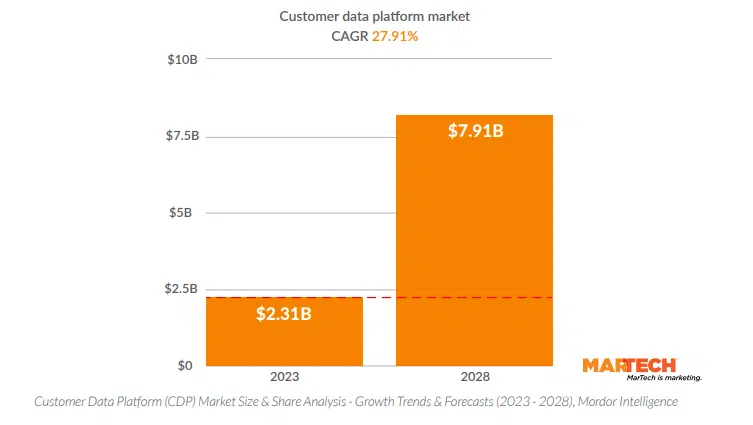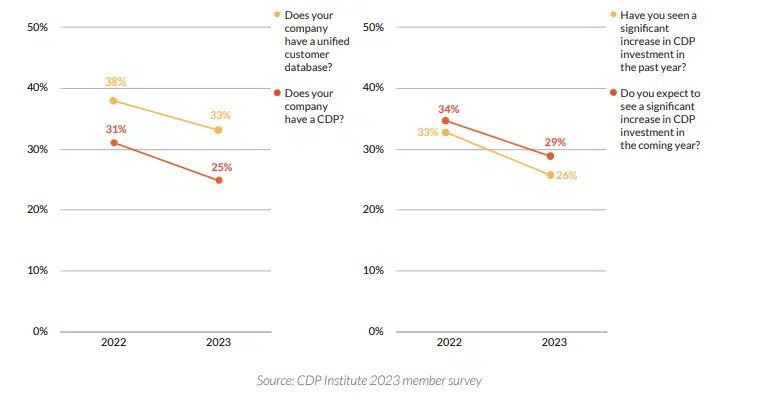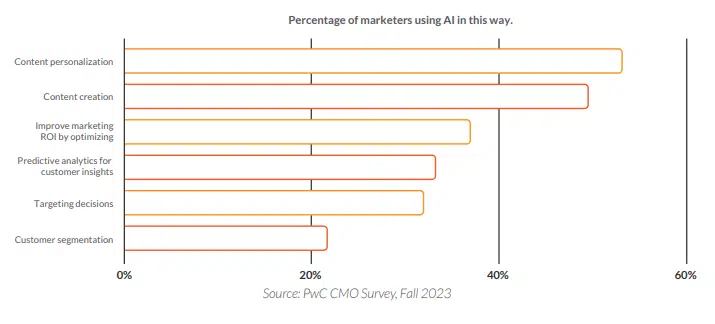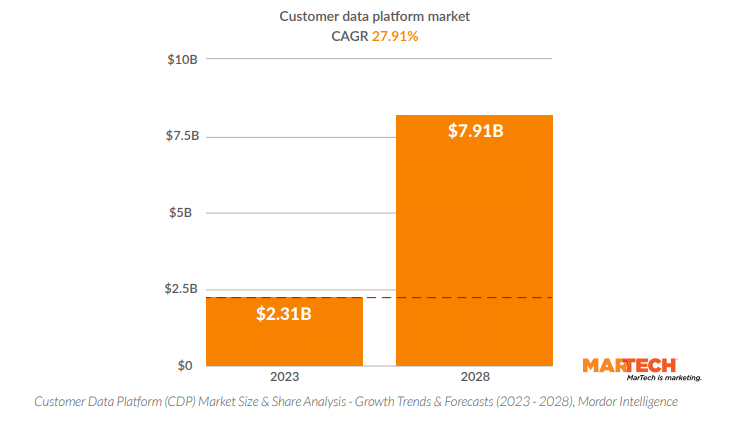The current business environment — increasingly omnichannel but with a heavy reliance on digital — requires successful marketers to capture, analyze and leverage data to deliver timely personalized interactions across every customer touchpoint.
At a time when uncertainty about everything from war to global warming to economics dominates the headlines, the customer data platform is increasingly seen as one of the musthave elements of the martech stack. Meanwhile, the boom in artificial intelligence and machine learning is driving vendors to enhance the capabilities of these platforms in a number of ways, making the value proposition even more attractive.
One factor driving this trend is the increasing importance of customer experience (CX), which is improved through timely data gathering, AI-assisted segmentation and the personalization of interactions. Fully 75% of global 100 organizations say CX is a top priority, according to Forrester Research.
At the same time, marketers are facing the gradual, but seemingly inevitable, extinction of thirdparty data as fuel for their marketing programs. Therefore, businesses are looking to CDPs to help them increase the first-party data they hold and engage in privacy-compliant practices like sharing through data clean rooms.
Dig deeper: Does your company need a CDP?
Market to triple by 2028
The global market for customer data platforms is expected to triple in size by 2028, according to a recent report by Mordor Research (See Figure 1). Annual spending on CDPs is predicted to grow from $2.13 billion in 2023 to $7.91 billion in 2028. North America is expected to account for the lion’s share of the market, while Asia Pacific will be the fastest-growing region.


CDP market makers
Here are just some of the key players in the CDP market space:
ActionIQ
ActionIQ specializes in the enterprise market across a broad spectrum of verticals. It employs specialized teams to handle regulated markets such as financial services.
ActionIQ CX Hub offers modular and scalable solutions that can be customized to meet the needs of enterprise clients. The software provides three architecture options, allowing IT teams to choose the best approach for their organizations.
The software consists of modular solutions, including Customer Data Platform, Audience Builder, Journey, Identity, and Real-Time CX, which can be easily added or expanded to meet changing customer needs.
Adobe Real-Time CDP
Adobe typically targets enterprise and mid-market organizations and works with a wide variety of roles across the marketing and IT organization.
Built on Adobe Experience Platform, Adobe’s Real-Time Customer Data Platform (Real-Time CDP) helps companies understand and connect with current and potential customers by using a complete foundation for data management, built-in governance controls and actionable unified profiles.
Real-Time CDP is available in B2C, B2B and hybrid editions so that organizations can create unified profiles for consumers and/or accounts and personalize in real-time across all channels.
BlueConic
For B2C and B2B companies with significant experience across consumer goods, retail/ecommerce, media and publishing, telecommunications and financial services sectors.
BlueConic’s pure-play CDP is designed to give transformation-minded organizations and their growth-focused teams, such as marketing, ecommerce, digital product and experience, and analytics, access to unified, actionable, and privacy-compliant firstparty customer data.
Salesforce Data Cloud
Aimed at high-growth companies to enterprise-level organizations across all industries, market segments and geographies.
Salesforce’s Data Cloud is a hyper-scale, real-time data platform that enables companies to leverage data by delivering highly personalized experiences that adapt to customer behavior and needs in real time.
Treasure Data
Treasure Data is focused on the enterprise – Global 2000/Fortune 500 companies. Key verticals include retail/CPG; healthcare; media and entertainment; technology; financial services; automotive; and travel and hospitality.
The Treasure Data customer data platform is designed to integrate into complex technology environments and is vendor-neutral and open by design. It includes a data lake that can manage customer data at any scale, with the ability to handle petabytes of compressed data, ingest over 2 million records per second, and run 1 million queries per day.
Twilio Segment
Twilio Segment serves both B2B and B2C organizations. The company works with large enterprise businesses in retail, technology, media, healthcare and finance. It also serves the needs of rapidly scaling, venture-funded growth and mid-market companies.
Segment helps companies get a complete, real-time view of customers, enabling them to easily build targeted campaigns and predictive audiences to orchestrate multichannel journeys that deliver personalized experiences.
Looking for a CDP? Download our buyer’s guide today and learn everything you need to know.
CDP trends
Despite the predicted growth in spending on customer data platforms, data about the enthusiasm
for implementing and fully using CDPs is contradictory.
Fewer respondents to an annual member survey reported having a unified customer database or CDP in 2023 versus 2022, according the CDP Institute, an independent industry group whose membership consists of vendors of CDPs and other martech, as well as agencies and CDP users.
Those who said they had a “unified customer database” fell from 38% in 2022 to 33% in 2023.
Those reporting that they had implemented a CDP fell from 31% to 25%.


It’s an odd development and represents the first time these percentages have fallen since the
organization began its surveys in 2017. A possible explanation for the reported decline in unified customer databases/CDPs may be that marketers who once thought they had a unified customer database now realize that their data isn’t as unified as they’d believed.
The phase-out of third-party cookies is driving soul-searching and strategy changes among marketers seeking to augment the amount and quality of data they have available for targeting and personalization. Many are re-evaluating their data situation after a long period of continuing to depend on third-party cookies despite knowing they would eventually have to cope with the reality of their demise.
Dig deeper: Real-time customer data platforms: The promise and the reality
The AI and machine learning revolution
Incorporating AI can make personalization even more powerful, enabling marketers to identify
lucrative segments and deliver content tailored for those individuals. Content personalization is
currently the purpose for which most organizations are utilizing AI, according to the PwC CMO
Survey, Fall 2023.


The extent to which this functionality and other AI and ML capabilities are integrated into today’s CDPs varies widely. Although predictive AI and machine learning have long been utilized by CDP vendors, the boom in generative AI, and the accompanying marketer adoption, are leading to more and splashier integrations.
This makes a lot of sense, given that these technologies are enhanced by the utilization of vast amounts of data, and CDPs serve as the center for that type of data within the enterprise.
Many of the uses of AI and machine learning in CDPs happen behind the scenes, where vendors use sophisticated models to cleanse and normalize data, to surface audiences based on their likelihood to respond to a particular offer, and to drive attribution models and testing.
When it comes to generative AI, CDPs are still in the early stages of exploring how it can enhance their offerings. Based on our discussions with vendors, we expect to see much more innovation in this arena in the coming years.
One of the nearer-term developments, with some vendors offering this already, are chat interfaces that allow marketers to ask questions of the CDP data in natural language, with responses provided both in text and in data visualizations. Others are implementing natural language interfaces to improve usability and reduce the steps necessary for users to accomplish a goal. Additionally, some campaign-oriented platforms are integrating content creation via large language models (LLMs) for image or text generation, to be used to develop ad campaign creative or email marketing messaging.
Fuel for your marketing strategy.
























































![Key Metrics for Social Media Marketing [Infographic] Key Metrics for Social Media Marketing [Infographic]](https://www.socialmediatoday.com/imgproxy/nP1lliSbrTbUmhFV6RdAz9qJZFvsstq3IG6orLUMMls/g:ce/rs:fit:770:435/bG9jYWw6Ly8vZGl2ZWltYWdlL3NvY2lhbF9tZWRpYV9yb2lfaW5vZ3JhcGhpYzIucG5n.webp)

















